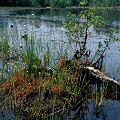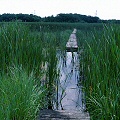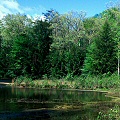Q: Why do most carnivorous plants live in wetlands?
A: Well let me clarify this a little first. Most wetlands are not suitable for carnivorous
plants. However, some are, and they are nutrient poor--usually acidic--freshwater wetlands. Meanwhile, some carnivorous plants
grow in areas that are completely dry for much of the year. Such areas--such as parts of Southwest Australia--have extremely sandy soils
with very low nutrient content. But it is true that most carnivorous plants live in certain types of wetlands.
In these nutrient-poor habitats, plants find life difficult because the necessary chemicals
they need to survive are in short supply. They grow more slowly than usual, reproduce less,
and are more prone to disease. They are starving!
Meanwhile, carnivorous plants can obtain nutrients through their remarkable abilities.
Catching bugs gives the carnivorous plants a competitive advantage over the
noncarnivorous plants. While the noncarnivorous plants grow poorly, carnivorous plants can thrive.
Meanwhile, in environments with plenty of available nutrients, the ability to catch bugs
does not confer an advantage to carnivorous plants. In such conditions, while a carnivorous
plant would be wasting its resources catching bugs, other plants are
putting energy into growing taller and stronger. The noncarnivorous plants would
outcompete the carnivorous plants.
For this reason, if the water or soil quality of a carnivorous plant habitat changes, the carnivorous plants
will perish, even though the overall health of the habitat seems good. You know the story of the canary in the coalmine?
Page citations: Juniper, B.E., et al. 1989; Rice, B.A. 2006a.



